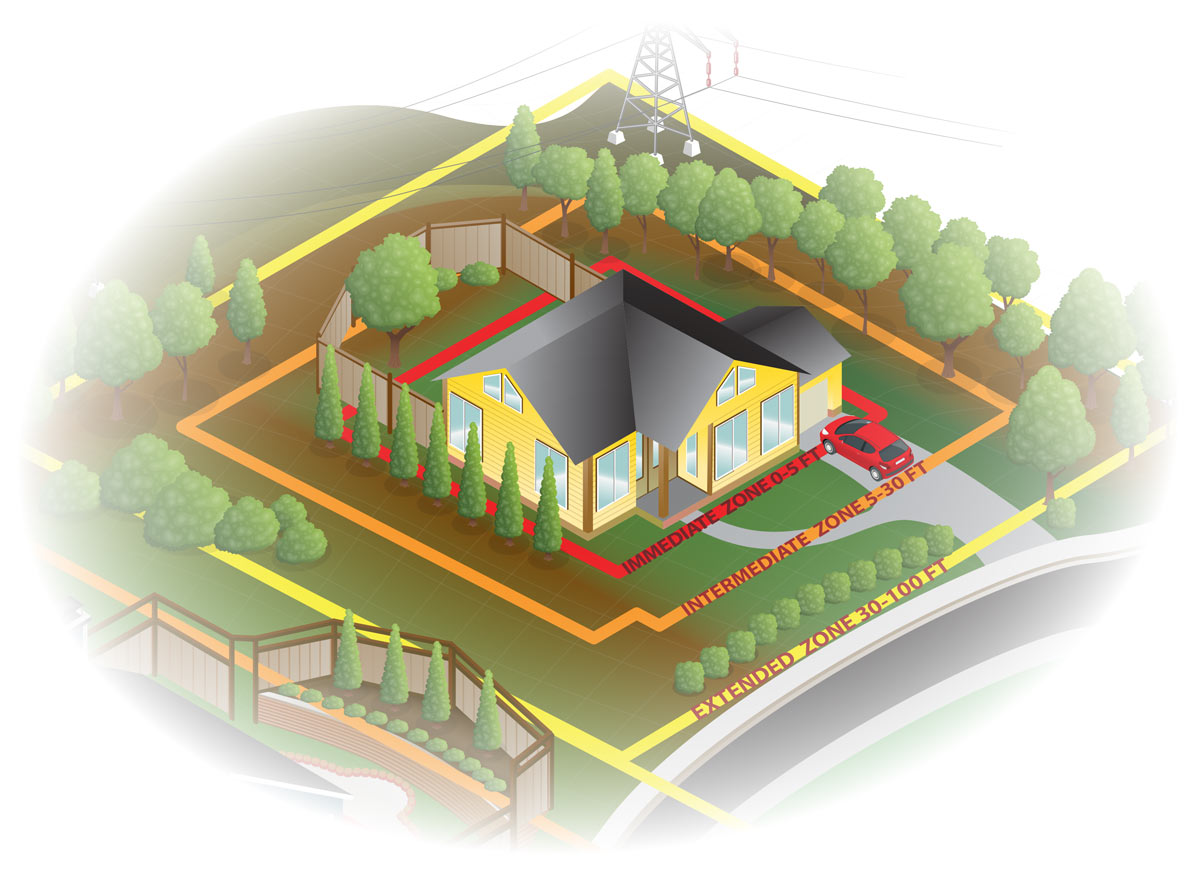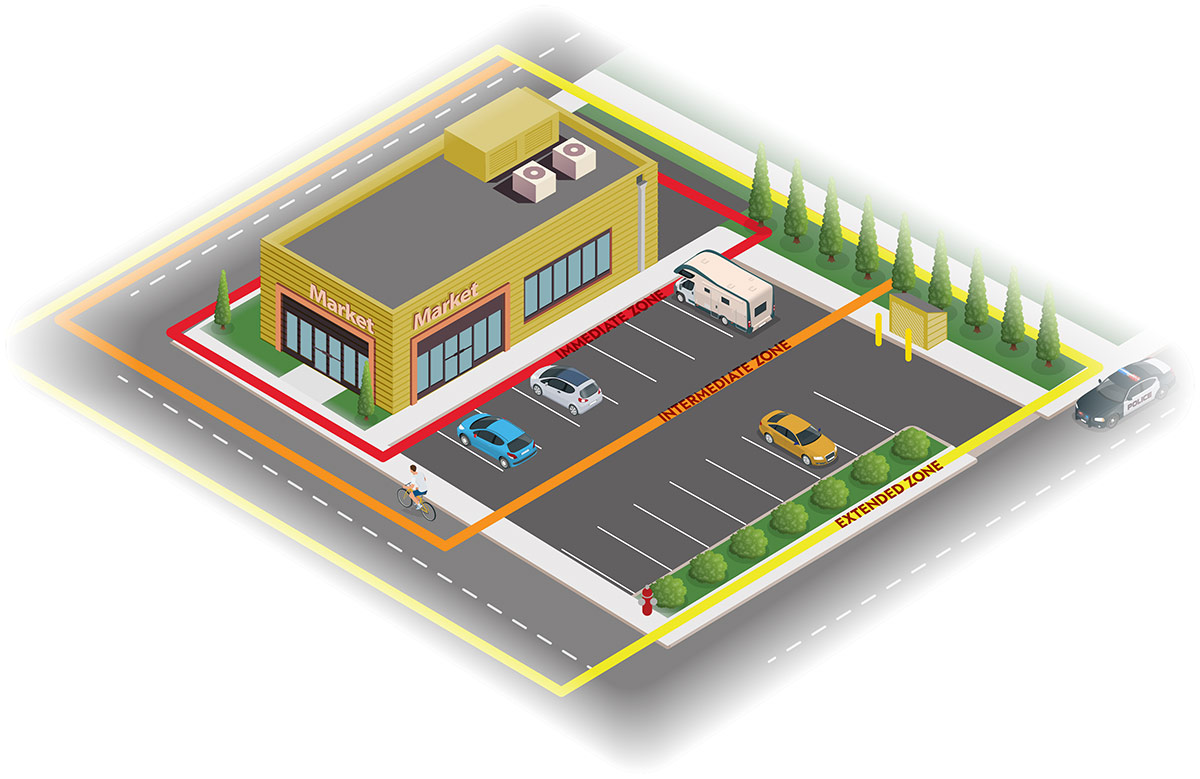Wildfire Risk is Rising
Wildfires pose a significant threat to communities, homes, businesses, and families. This page serves as a comprehensive guide on how to protect yourself, your home, your family, your community, and your business from the devastating impact of wildfires. By taking proactive measures and understanding the steps involved, you can significantly reduce the risk and ensure safety during these challenging times.
On this page you will find:

Protect Yourself and Your Family
The most important thing you can do to take care of yourself and your family is to be prepared.
Stay informed: Monitor weather updates from reliable sources, such as local authorities or the National Weather Service. Be aware of any evacuation orders or shelter-in-place advisories in your area.
Stay prepared and keep track of fires near you. AirNow’s Fire and Smoke Map shows fires throughout North America and NOAA’s Fire Weather Outlook page maps fire watches and warnings.
The Federal Emergency Management Agency (FEMA) app, can be used to receive real-time weather alerts, send notifications to loved ones, locate emergency shelters and FEMA Disaster Recovery Centers, and more.
The American Red Cross Emergency App, lets you customize 40 different weather alerts and has an interactive map to help you find open Red Cross shelters.
The Center for Disease Control (CDC) offers useful tips for preventing heat-related illness.
Also, using weather.gov as a valuable resource can help you proactively protect yourself before a disaster strikes by providing accurate and up-to-date information on severe weather conditions, warnings, and forecasts specific to your location, empowering you to make informed decisions and take necessary precautions to ensure your safety.
People with disabilities: Preparing for disasters is crucial for everyone, but it becomes even more vital for individuals with disabilities, who may have specific needs and require additional support during emergencies. Find practical steps and considerations to ensure the safety and well-being of people with disabilities in the face of potential disasters here.
Create an Evacuation Plan: Evacuate as soon as possible. Prepare this plan well ahead of a wildfire and make sure everyone in your household knows it. It should include:
- Meeting Point: Choose a specific meeting spot outside the fire-affected area. This is crucial to know who has safely left the danger zone.
- Escape Routes: Identify multiple ways to leave your home and community. Practice these routes regularly with your family so everyone knows them well. In case of a sudden evacuation due to a nearby wildfire, smoke can reduce visibility and cause confusion, so practicing these routes is essential.
- Pet and Large Animal Plan: Have a plan for evacuating pets and large animals like horses and livestock.
Prepare an Emergency Kit: Assemble a well-stocked emergency kit that includes essential supplies such as non-perishable food, drinking water, medication, flashlights, batteries, a first aid kit, important documents, and a battery-powered radio. Customize the kit according to your family’s specific needs, including items for infants, older adults, and pets.
Evacuation Planning: Follow evacuation orders issued by local authorities promptly. Your safety is their top priority. Plan multiple evacuation routes and practice them with your family. If you need to evacuate, turn off gas, electricity, and water supplies before leaving.
The Red Cross has an evacuation checklist that walks through all the necessary steps to make sure you safely and quickly evacuate the area in the case of a wildfire.
Create an Emergency Communication Plan: Choose an out-of-area friend or relative as a point of contact to act as a single source of communication among family members in case of separation. It is easier to call or message one person and let them contact others than to try and call everyone when phone, cell, and internet systems can be overloaded or limited during a disaster and under a stressful situation.
Prepare an Emergency Supply Kit: Prepare a “go bag” stocked with essentials before a wildfire or other disaster occurs and keep it easily accessible so you can take it with you when you evacuate. To make it easier to transport, keep it light enough to be able to lift it into your car if you drive or light enough to walk with if you don’t.
When You Have to Shelter in Place
Wildfires are unpredictable, and even the best-laid plans can go amiss. If you find yourself trapped by a wildfire or unable to evacuate, you can take steps to increase your safety. Here’s what you can do:
What to do Inside Your Shelter: If you cannot evacuate, you must stay inside the shelter until the fire front passes. Although it will be very hot, it can be four or five times hotter outside.
- Close all windows and doors; place wet towels under doors and window openings.
- Have fire extinguishers out and ready to use.
- Fill sinks, tubs, and buckets with water for extinguishing any embers that may enter the space as well as for drinking and flushing toilets.
- Plan for loss of power. Have flashlights and batteries ready.
- Close metal window blinds. Remove flammable window treatments.
- Move furniture away from windows and sliding glass doors.
- Shut off all fans and air conditioners to keep smoke and ash from being drawn into the structure and circulated.
- Wet or remove swamp cooler pads to prevent them from catching on fire.
- Bring pets inside and place them in carriers.
- Put livestock and horses in an irrigated pasture or area where fuels have been removed.
- Leave exterior and interior lights on to help firefighters find your house in dense smoke.
- Stay in the center of the structure, away from windows and glass doors.
What to do Outside Your Shelter:
- Strategically place sprinklers to wet your shelter and surroundings. Turn on until the wildfire has completely passed.
- Protect some hoses from flames by keeping them inside the shelter and have them ready to use once the fire front has passed.
- Close exterior doors and windows but leave them unlocked.
- Close or cover outside attic, eave, and basement vents to prevent embers from entering.
- Move all flammable materials at least 30-feet away from your shelter, including vehicles and recreational equipment, lawn furniture, and firewood.
- Plan for loss of power. If you rely on well water, have emergency generators ready to power your well’s pump.
- Store water for putting out embers or small fires after the fire front has passed.
- Shut off natural gas and propane.
- Open gates to prevent flames from spreading from a fence to your shelter.
Trapped in Your Vehicle: If you’re trapped in your car during a wildfire, do your best to stay calm. Sheltering in a vehicle during a fire can be dangerous and tense, but it’s still safer than being outside. The following steps are recommended if you must shelter in your vehicle:
- If you must stop, park away from the heaviest trees and brush like a driveway, parking lot, or empty side road. Keep the keys in the ignition and the engine on since it might not restart after the fire if you turn it off.
- Turn your headlights and hazard lights on to make your car more visible. You want any firefighters or rescue teams to be able to see your car.
- Make sure every window is completely closed. Shut your doors, close or block your air vents and set your air conditioner to recirculate.
- Lay out on the floor of the car, below the window level which helps protect you from the radiant heat as the fire gets closer.
- If you have a blanket or coat, use it to cover up your body as much as possible. You can also place cloth over your nose and mouth to help you breathe.
- Stay in your car as the fire front crosses. Be prepared for the temperature to rise dramatically and the car to get smoky. The outside of the car may catch on fire and be rocked by air currents, but it will still be safer than being outside the vehicle. Metal gas tanks and containers rarely explode.
- After the fire front has passed, get out of the car carefully and move to an area that’s already been burned. The air will still be smoky, so keep a cloth over your face to breathe through. If you have an operating cell phone call 911 to request emergency assistance.
Other Wildfire Preparedness Considerations:
- Have fire extinguishers on hand and make sure everyone in the family knows how to use them. Many fire extinguishers have expiration dates, so make sure to check yours.
- Ensure you and your family know where the home’s gas, electric, and water main shut-off controls are located and how to safely shut them down in an emergency.
- Maintain a list of emergency contact numbers in your cell phone, posted near your home phone, and in your emergency supply kit.
- Keep an extra Emergency Supply Kit in your car in case you cannot get to your home because of a fire or other emergency.
- Have a portable radio or scanner to follow the local news so you can stay updated on wildfires.
Your proactive efforts and readiness play a pivotal role in securing your safety during a wildfire. By adhering to official guidance and recommendations, you can effectively shield your loved ones and ensure their protection in wildfire emergencies. By understanding the measures to take and having a clear plan, you can navigate these challenging situations.

Protect Your Home
Years of research have proven that both your house and the land around it play a crucial role in whether your home can survive a wildfire. The materials your house is made of, its design, and the way you manage the area around it all affect how much it can withstand before catching fire.
The Home Ignition Zone is a roadmap to help you think about wildfire safety in three distinct areas around your property. Closest to your home is the Immediate Zone, where you should remove all flammable items. A bit farther out is the Intermediate Zone, which should have fewer, well-spaced plants. The farthest area, the Extended Zone, should be designed to slow down an approaching fire with low grass and spread-out trees.
The Immediate Zone
This zone covers your home and the 5 feet of space around it. Your primary goal is to remove anything that could ignite easily. This includes materials on your roof, like shingles, as well as plants or items near your home that could catch fire from embers, radiant heat, or direct flames.
To make your property safer from wildfires, begin with your house and then work on managing the surrounding landscaping. Many communities offer a fire-risk assessment by local forestry or fire agencies, which can provide specific guidance tailored to your property and location. Here are some steps you can take to protect your property.
Hardscaping in the Immediate Zone
Check Your Insurance: Standard home insurance typically covers wildfire damage, but coverage may differ by geographic location and policy. Be sure to check your policy, update it with any home improvements and keep an inventory of your belongings for insurance claims. Take pictures or video of each room and save receipts from major purchases.
Home Address: Ensure it’s easily visible from the road.
Roof: The roof is the most vulnerable part of your home. Homes with wood or shingle roofs are at high risk of being destroyed during a wildfire. Use non-flammable roofing materials and remove debris from your roof.
Vents: Vents on homes create openings for flying embers. Cover vents with 1/16-inch to 1/8-inch metal mesh to prevent embers from getting inside.
Eaves and Soffits: You should enclose the eaves (the part where the roof overhangs the walls) using non-burnable materials like a small metal screen or cement panels. This prevents fiery embers from getting stuck near flammable wood surfaces.
Rain Gutters: Keep them clear to prevent the accumulation of debris and use a noncombustible gutter cover to prevent buildup of debris and vegetation in the gutter. Consider installing metal flashing.
Windows: During a wildfire, the intense heat can break windows even if the house isn’t burning yet. When this happens, embers can get inside and start fires indoors. Single pane and large windows are especially at risk. Consider limiting the size and number of windows facing large areas of vegetation and install dual-paned windows with tempered glass. Use ember-resistant coverings.
Chimney: To stop embers from escaping and causing a fire, put non-flammable screens over your chimney and stovepipe openings. Make sure the holes in the screens are between 3/8-inch and 1/2-inch in size. Close the fireplace flue during fire season when the chimney is not being used.
Walls: Wood materials like boards, panels, or shingles are often used for siding, but they can easily catch fire. They’re not the best option for places where fires are more likely to happen. Use fire-resistant materials for siding.
Decks: Use non-combustible materials and create an ember-resistant zone.
Fences: Keep them away from your home or upgrade the last 5 feet to non-combustible material.
Landscaping in the Immediate Zone
- Regularly clear dead vegetation and debris.
- Keep hardscape areas free of litter.
- Use concrete, stone, or gravel for walkways.
- Remove or replace flammable trees and shrubs.
- Replace wood mulch with non-combustible options.
- Trim overhanging tree limbs.
The Intermediate Zone
This zone covers 5 to 30 feet from your home. Your primary goal here is to reduce flammable materials and vegetation that could produce embers, direct flames, or radiant heat that might set your structure on fire. Here’s what to do in this zone:
- Clear vegetation around and under low-lying stationary objects such as propane tanks.
- Keep lawns and native grasses trimmed to four inches in height.
- Remove undergrowth (known as ladder fuels) to keep surface fires from reaching tree crowns, typically 10 feet or higher. Trim trees 6 to 10 feet from the ground or 1/3 of their height for shorter trees.
- Keep plants, trees, and lawns well-watered to prevent them from drying out.
- Where possible, space trees at least 18 feet apart, increasing the distance on slopes.
- Limit the number of trees and shrubs to small clusters to break up continuous vegetation.
- Plan tree placement so that the mature canopy is at least ten feet away from the structure’s edge.
The Extended Zone
This zone begins 30 feet from your home and goes up to 100 feet or your property line. If your property line ends prior to 100 feet, working collaboratively with your neighbor is important to help protect multiple properties. Your primary goal here is to manage dense forests, dead plants, and branches that reach over or near your roof. This helps reduce the risk of wildfire spreading, making it less intense and producing fewer embers. Here’s what to do in this zone:
- Clean up heavy piles of debris on the ground.
- Get rid of dead plants and trees and plants near storage sheds or other buildings in this area.
- For trees 30 to 60 feet from your home, make sure there’s at least 12 feet between their tops. For trees 60 to 100 feet away, maintain at least 6 feet of space between their tops.
Incorporating the principles of the three ignition zones into your wildfire protection plan is key to safeguarding your home and significantly reducing your home’s risk. Remember that these zones are not just guidelines but vital strategies that, when executed effectively, fortify your home’s defenses. By investing the time and effort into these protective measures, you’re not only preserving your property but also creating a safer environment for your family and community in the face of wildfire threats.

Protect Your Business
The Occupational Safety and Health Administration (OSHA) provides guidelines and regulations that businesses must follow to protect workers during emergencies. Their role in a business’s emergency preparedness and response is to establish regulatory requirements, provide guidance, and promote a safe and healthy work environment for employees, thereby minimizing risks and ensuring the protection of workers during emergencies. Find more information on how to prepare and train for emergencies and the hazards to be aware of when an emergency occurs here.
Keep in mind that for some of these actions, coordination with property owners may be necessary in rental or lease situations. The evaluation below covers the three areas (Ignition Zones) around the building to improve overall safety. Closest to your business is Zone 1, where you should remove all flammable items. A bit farther out is Zone 2, which should have fewer, well-spaced plants. The farthest area, Zone 3, should be designed to slow down an approaching fire with low grass and spread-out trees. These suggestions follow the National Fire Protection Agency’s standards and guidelines found in NFPA Standard 1144, which focuses on reducing the risk of structures catching fire from wildland fires. Below are specific suggestions for businesses to consider.
The Immediate Zone
This is the area 0-5 feet around your business structure. Your primary goal here is to create a defensible space immediately around your business structure to reduce the risk of fire ignition. Here are some steps you can take to improve your safety:
- Use non-combustible siding materials for exterior walls.
- Cover vents with 1/8-inch metal screens to prevent embers from entering.
- Shield eave areas with 1/8-inch metal screens or non-combustible fiber cement paneling.
- Use dual-paned windows with tempered glass for better fire protection.
- Choose non-combustible roofing materials like composite shingles, clay, or metal.
- Keep roofs and gutters free of flammable debris.
- Secure decks by using non-combustible materials or screens.
- Store flammable items safely and clear balconies during high fire danger.
- Maintain a 5-foot clearance around the structure, free of flammable materials.
The Intermediate Zone
This is the area extending 5-30 feet from the structure. Your primary goal here is to create a fire-resistant landscape and buffer zone that adds an additional layer of protection against the spread of wildfires toward your business. You can start by:
- Keeping lawns and grasses mowed to a height of four inches.
- Watering plants, trees, and lawns to prevent them from drying out.
- Spacing trees at least 18 feet apart, with greater distance on slopes.
- Removing vegetation under trees and prun them 6 to 10 feet from the ground.
- Placing trees so mature canopies are at least ten feet from the structure.
- Clearing vegetation around stationary propane tanks and secure trash bins.
The Extended Zone
This area extends 30-100 feet from the building. It may include part of your neighbors’ property. In this case, it’s best to collaborate as this will ensure the safety of multiple structures. Your primary goal here is to create a larger and more defensible space around your business structure to significantly reduce the intensity and potential spread of an approaching wildfire. These steps can enhance your safety:
- Reduce vegetation to slow wildfire spread.
- Remove ground litter and debris.
- Eliminate dead plant and tree material.
- Clear small trees growing between mature trees.
- Maintain 12 feet between canopy tops of trees located 30 to 60 feet from the business to reduce fire intensity and spread.
Review Insurance Coverage: Consult with your insurance provider to understand your coverage and ensure it is sufficient to protect your assets and operations. Consider obtaining coverage for business interruption, property damage, and other relevant policies specific to your industry.
Develop a Business Continuity Plan: Create a comprehensive Continuity of Operations Plan (COOP) that outlines steps to be taken before, during, and after a disaster. Identify critical operations, key personnel, and establish alternative communication channels and backup systems.
Train and Protect Employees: Ensure sufficient fire extinguishers are available and placed in strategic areas like near loading docks and waste collection areas. Keep them in good shape and teach your employees how to use them properly. Have fire protection systems checked by professionals on a regular basis. Create a communication plan that can reach your employees in multiple ways, and don’t forget to practice it with your team from time to time so everyone knows what to do if there’s a fire.
Understand Your Building’s Water Supply: Consider maintaining a water supply at your facility to control small fires until emergency personnel can arrive. If a natural water source is available, think about a water pump and hoses at your facility. A generator is an ideal option in case of downed power lines if your water pump uses electrical power.
Reduce Plant Fuel Sources Around the Property: When you’re landscaping around your building, go for plants that are less likely to catch fire. Look for ones with high moisture content, low oil or resin content, deep roots and thick leaves. It’s all about creating a plan to keep your greenery from becoming a fire hazard. Click here for more information on choosing fire-resistant plants.
Store Potential Fuel Sources Carefully: Be cautious about where you store wooden pallets, flammable liquids and other combustibles. Store these materials where they won’t be easy fuel for an advancing fire. If you have a residential business such as an apartment complex or condos, require tenants to remove all combustible items from balconies and decks during high fire danger periods.
Use Non-Combustible Materials for Signage: This is a crucial safety measure as it increases the structures fire resistance, enhances the safety of its occupants, and improves the durability of the building.
Safeguarding your business before, during, and after a wildfire is not just a matter of protecting assets; it’s about ensuring the well-being of your employees, community, and future. By following the guidelines here, your business will be better equipped to weather the challenges posed by these unpredictable events. Remember, preparedness is not an option; it’s a necessity in the face of wildfire threats. Your commitment to safety and resilience will not only protect your business but also contribute to the strength of your community.

Protect Your Community
Individuals play an important role in taking steps to decrease their vulnerability to wildfires but communities can also play a pivotal role in reducing their collective exposure to this threat. Collaborative efforts within communities can lead to the implementation of preventive measures and foster a robust sense of community resilience. Below are actions that communities can undertake to reduce their collective risk of wildfires:
Educate and Raise Awareness: Arrange community meetings where local fire experts come to talk to residents about wildfires and how to stay safe. They can cover topics like:
- The history of fires in the area.
- How to plan in case of evacuation.
- Tips for making your home and neighborhood safer from wildfires.
- How to get important alerts from local authorities.
Make a Wildfire Plan: Work with your local fire department and forestry agencies to create a plan for your neighborhood in case of a wildfire. They can help:
- Identify potential evacuation routes, safe meeting places, or staging areas (large open spaces outside the immediate danger zone, offering protection from the wildfire that is easily accessible to residents).
- Encourage fire safety by providing information on landscaping and non-flammable building materials.
Conduct Community Fire Drills: Organize periodic neighborhood drills to practice evacuation procedures and response actions.
Keep an Eye Out for Trouble: Start a neighborhood watch program to watch out for possible hazards. Ask your neighbors to report anything that doesn’t look safe, like illegal fires or campfires left unattended.
Work Together to Cut Fire Risks: Team up to clean up overgrown plants and get rid of dead trees that could make fires worse.
Be Careful with Outdoor Fires: Create guidelines for safe outdoor fires and encourage residents to follow them. Watch the weather and avoid fires during periods of high fire danger.
On a broader scale, an entire community can team up to create a more detailed plan to protect themselves from wildfires. This plan is called a Community Wildfire Protection Plan, and it’s a structured and thorough process. It requires government officials, community leaders, residents, local businesses, and others to work together to develop and execute a wildfire protection plan for the entire community. It is not unusual for the plan to take several years. You might need to get funding from grants and other sources to pay for large community protection projects like creating fuel breaks. It may also require zoning and general land management ordinance changes. This could include creating parks or open spaces to reduce flammable plants and having regulations on using fire resistant building materials for new construction. Click here to learn more about why Community Wildfire Planning is important, what is required, instructions and guides on how to complete the plan.
Protecting yourself, your home, your business, and your community from wildfires is a shared responsibility that requires proactive planning, cooperation, and vigilance. We all have a part to play in the face of a changing climate and increased wildfire threat. By implementing the strategies and guidelines discussed on this page, you can significantly reduce the risk and impact of wildfires. Remember that wildfire prevention is a shared responsibility, and everyone’s active participation is essential in creating a safer environment.


